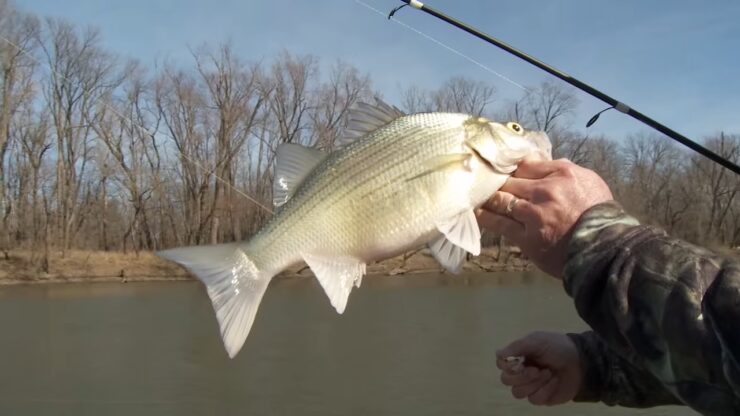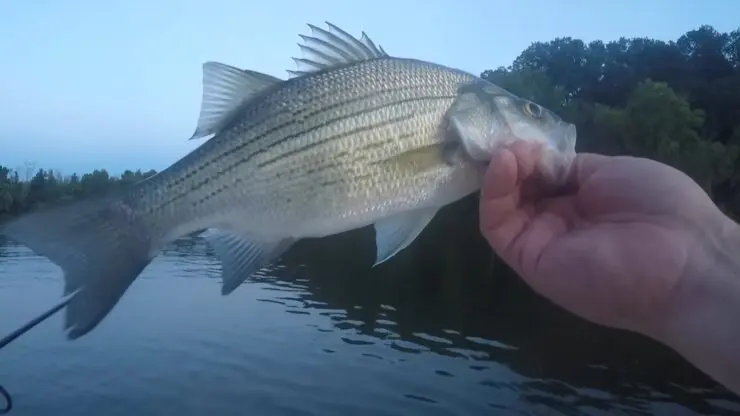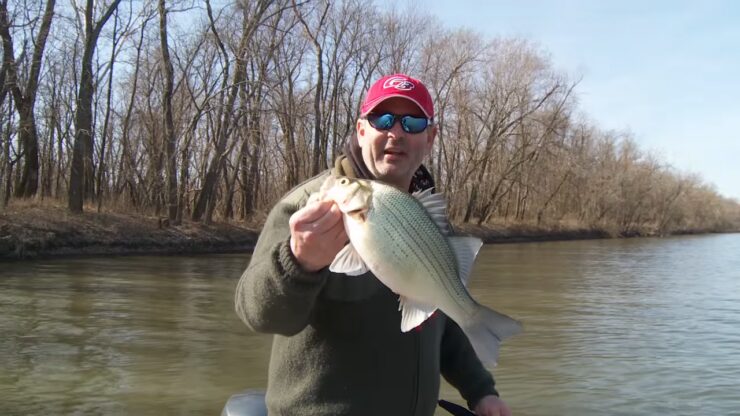In Spring, white bass (also called sand bass, and stripe) seek out tributaries to spawn in, and the action is fast and furious. Some people only fish for them in Spring, which is a shame, because they are active all winter.
They can be found along with sunken islands, channels, old riverbeds, over sandy bottoms, and another hardcover. They patrol in search of their favorite food, shad. They will eat any small fish but they are especially fond of shad.
They also love to congregate below tailraces in winter. So there is no need to hang up your rods and garage the boat just because Old Man Winter has arrived.
Table of Contents
ToggleWhite Bass Basics
White bass ( Morone chrysops) is true basses, unlike the Black Basses, which are actually panfish related to crappie and bluegills. They are closely related to the marine striped bass, which has been acclimated to freshwater and has been stocked all over the US in larger reservoirs.
Striped bass and white bass are often confused with each other, especially in smaller specimens. Their habits overlap greatly. To complicate matters further, a hybrid has been created. There are three ways to tell the difference between a white bass, and striped bass.
White bass is deeper in the body, while striped bass is streamlined. White bass stripes are broken, faint and few go all the way to the tail. Striped bass stripes are distinct and most go all the way to the tail. The most surefire way to tell the difference is to look at the tooth patches on their tongues.
White bass only has one patch, while striped bass has two. Hybrids will have characteristics of both species. If you catch one with broken stripes and two tooth patches, it is a hybrid.
Another close relative is the yellow bass. It looks like a white bass except it has a brassy yellow color. They are beautiful fish, but seldom get over a pound or two in size. White bass can average around 3-4 lbs.
Stripers are behemoths and can weigh as much as 80 lbs or more, with the average being around 15-20 lbs. All 4 species have the same habits. They travel in large schools, cruising open water looking for schools of shad, which they attack with vicious feeding frenzy behavior.
White bass and hybrids often school together, but striped bass usually schools by themselves.
Fishing methods for all species are the same. The only difference is the size of the bait you need.
Tactics: How To Catch White Bass
White bass like cooler water, and in winter, they travel open water in large schools looking for shad, and other schools of baitfish. They can cover several miles per day and travel all over large lakes. When you find them, usually it is not hard to catch them, but at times they can be very picky about size and color. It’s best if you can match the size and color of your lure to what they are eating at the time.
You can, of course, net your bait so that you know you have what they are used to eating, but shad do not live long on a hook, and white bass will not touch a dead minnow or shad (but save them, because they make outstanding catfish bait…). You need to be able to cover distance quickly to keep up with a school once you have found them, so lures are usually more productive.
In winter, white bass will be cruising off of sandy points along channels and drop-offs, sunken islands, rip-raps, and any other type of hard structure. They will not be anywhere near trees, bushes, sunken timber, etc… They are strictly open water fish, and only eat other fish, so worms, crawfish, and other baits will not work.
Depth finders can be really helpful, but the best way to find them is by Jump Fishing. All you really need is a pair of decent binoculars or a drone with a camera. Have a couple of rods rigged up and ready to go with suitable baits.
When white bass finds a school of baitfish, they attack them like piranhas. Many of the hapless baitfish try to jump out of the water to escape, only to be attacked by birds at the surface, and more white bass if they survive the jump. White bass is so vicious that baitfish get thrown from the water. This makes the surface of the water boil and churn, and is visible from quite some distance.
Also, flocks of birds will be wheeling and diving in a frenzy to get their share of the bounty.
White bass frenzy

When you see wheeling birds and boiling water, that’s where the fish are. Get over to that area, but don’t power all the way in. You may spook the school and make them dive. Shut your motor off (if you have one, otherwise, stop paddling) and coast into casting range. Throw a little past the school and reel through them. Hang on because strikes will be hard and sudden. It’s not uncommon to catch a fish on every cast.
After a few minutes, the school will go down and resurface in another location, usually within 100 yards or so. When the action stops, break out the binoculars and look for them again. It won’t be long before they resurface.
You can stay in contact with schools all day like this. I have a few friends who even use drones to locate the schools, and they seem to do alright. I’ve never tried it, but it sounds like a lot of fun, even if you don’t find any fish…. I’m gonna have to get me one of those someday….
When the sun sets, you don’t have to give up. White bass bite all night. You can use a depth finder and spider rigs to find them. They will still be cruising the same areas.
Another way to fish for them is below tail races behind dams. You can cast up current and reel down as the current carries your lure or bait. At the end of the drift, reel in and repeat. You can use a float to hold the bait off the bottom if you want. Just let the current carry the float and take up slack as it drifts.
My favorite method for tail races is to rig two marabou jigs, one white and one yellow or chartreuse, one above the other, and place a large float about 3 feet above them. Cast this rig into the gates and let the current carry it downstream. If the float stops, changes direction, bobs, moves sideways, or goes under, set the hook, hard. White bass have a hard mouth. It is not uncommon to catch two at a time with this rig.
Two Marabou rig
My all-time favorite lure for white bass is without question, the Mann’s Little Suzy/Little George. These lures are the same except the Suzy has a flat head and the George has a round head.
I have never noticed a difference between the two as far as catching fish.
These are tail spinners that also wiggle violently on the retrieve. I have caught white bass, striped bass, both species of black bass, and even a northern pike on these lures. The best colors are grey and white.
The next best lure for white bass that I have used is a soft body shad, like the Sassy Shad, or Lil Fishie. Again, the best colors are grey and white, or chartreuse and white. It has never seemed to make much difference as to the water clarity in my experience.
These colors have always worked best for me. And lastly, white, or chartreuse marabou jigs have always produced well for me for just about all species. For white bass, I like the ⅛ oz. size, but ¼ oz. is not too big.
A medium-action spinning, or spin-cast rod and reel combo is plenty for white bass. Anything more is overkill.
It is really not difficult to find and catch winter white bass. It can be some of the best fishing of the year.
Happy fishing
Meet Maria Alexander, the fearless adventurer steering the ship at KayakPaddling.net. Her mission? To convince you that life’s too short for dry land and that the best stories always start with “So there I was in my kayak…”
Related Posts:
- Heavy Duty Fishing: 11 Best Rods And Reels For Big Fish 2024
- 12 Best Fishing Lures Ever 2024 - Baits That…
- 16 Best Kayak For Beginners 2024 - Kayaking Adventure Gear
- 10 Best Saltwater Fishing Boats - Ultimate Angling Adventure
- 12 Best Kayak GPS 2024 - Find Your Way to Adventure
- 10 Best Hobie Fishing Kayaks 2024 - Best Kayak for…












